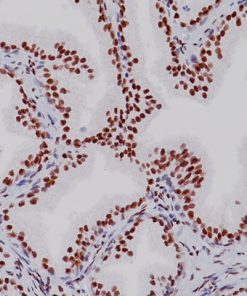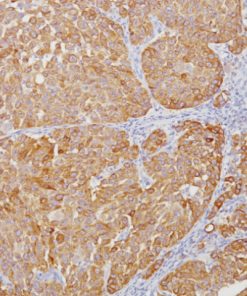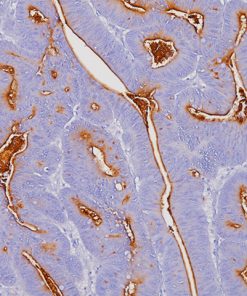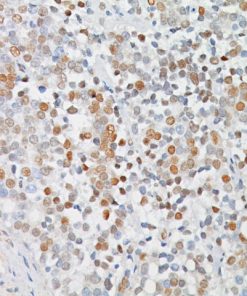CDX2 (M) + CDH17 (RM)
$773.00
Description
Product Description
CDX2 is a homeobox gene that encodes an intestine-specific transcription factor (1). CDX2 has been useful to establish gastrointestinal origin of metastatic adenocarcinomas and carcinoids and can be especially useful in distinguishing metastatic colorectal adenocarcinoma from tumors of unknown origin (1-7). CDX2 has been shown to be more specific and more sensitive than villin or CK20 (1,4,6). CDX2 has also been shown to be expressed in mucinous ovarian cancer, bladder adenocarcinoma, cholangiocarcinoma and malignant germ cell tumors of the testes (1,2,6-8). Only very rare examples of carcinomas of the genitourinary and gynecologic tracts or breast, lung, and head and neck cancers showed elevated levels of CDX2 expression (1).
CDH17 (Cadherin 17 or LI-cadherin) is a novel oncogene expressed in intestinal epithelium which is involved in tumor invasion and metastasis (9-10). CDH17 is a highly specific marker in colon cancer (99/99, 100%) and is a more sensitive marker than CDX2 (93/99, 94%) and CK20 (91/99, 92%) (11). Overexpression of CDH17 (and conversely, under expression of CDX2) correlates to poor prognosis in patients with epithelial ovarian cancer (1). CDH17 may be helpful for early diagnosis of Barrett’s
esophagus (12). CDH17 has been shown to be a useful marker for distinguishing between primary urinary bladder adenocarcinoma and urothelial carcinoma with glandular differentiation (13). Note that CDH17 does not distinguish primary urinary bladder adenocarcinoma from colorectal adenocarcinoma secondarily involving the bladder (13). In addition, 89% of medullary carcinomas of the colon and rectum were recognized by CDH17 (14).
Compared to CDX2 or CK20 alone, the combination of CDX2 and CDH17 is highly sensitive and somewhat specific for colorectal and stomach adenocarcinoma in routine immunohistochemistry, especially in cases with a CK7-/CDX2-/CK20- carcinoma (6,10,14). Data suggests that the combination of CDX2 and CDH17 along with CK7 may improve specificity compared to the panel consisting of CD20, CDX2, villin and CK7 (1-13).
Specifications
Specifications
| Intended Use | |
|---|---|
| Format | |
| Volume | |
| Source | |
| Clone | |
| Isotype | |
| Antigen | |
| Localization | |
| Positive Control |
Datasheets & SDS
| Download Data Sheet |
| SDS Sheet |
Browse more documents for this product (IFUs, datasheets, translations, SDS, and more).
References
1. Werling RW, et al. CDX2, a highly sensitive and specific marker of adenocarcinomas of intestinal origin: an immunohistochemical survey of 476 primary and metastatic carcinomas. Am J Surg Pathol. 2003 Mar; 27(3):303-10.
2. Moskaluk CA, et al. Cdx2 protein expression in normal and malignant human tissues: an immunohistochemical survey using tissue microarrays. Mod Pathol. 2003 Sep; 16(9):913-9.
3. Kim JH, et al. Utility of thyroid transcription factor-1 and CDX-2 in determining the primary site of metastatic adenocarcinomas in serous effusions. Acta Cytol. 2010 May- Jun; 54(3):277-82.
4. Saad RS, et al. CDX2, cytokeratins 7 and 20 immunoreactivity in rectal adenocarcinoma. Appl Immunohistochem Mol Morphol. 2009 May; 17(3):196-201.
5. Qi W, et al. Characterization and applications of a newly developed rabbit monoclonal antibody to cytokeratin 7 (CK7) for immunohistochemistry. Appl Immunohistochem Mol Morphol. 2009 May; 17(3):233-8.
6. Bayrak R, Haltas H, Yenidunya S. The value of CDX2 and cytokeratins 7 and 20 expression in differentiating colorectal adenocarcinomas from extraintestinal gastrointestinal adenocarcinomas: cytokeratin 7-/20+ phenotype is more specific than CDX2 antibody. Diagn Pathol. 2012 Jan 23; 7:9.
7. Lee MJ, et al. CDX-2 expression in malignant germ cell tumors of the testes, intratubular germ cell neoplasia, and normal seminiferous tubules. Tumour Biol. 2012 Dec; 33(6):2185-8.
8. Vang R, et al. Immunohistochemical expression of CDX2 in primary ovarian mucinous tumors and metastatic mucinous carcinomas involving the ovary: comparison with CK20 and correlation with coordinate expression of CK7. Mod Pathol. 2006 Nov; 19(11):1421-8.
9. Huang LP, et al. Up-regulation of cadherin 17 and down-regulation of homeodomain protein CDX2 correlate with tumor progression and unfavorable prognosis in epithelial ovarian cancer. Int J Gynecol Cancer. 2012 Sep; 22(7):1170-6.
10. Panarelli NC, et al. Tissue-specific cadherin CDH17 is a useful marker of gastrointestinal adenocarcinomas with higher sensitivity than CDX2. Am J Clin Pathol. 2012 Aug; 138(2):211-22.
11. Tacha D, Zhou D. CDH17 is a highly specific marker and is a more sensitive marker than CDX2 and CK20 in colon cancers. Poster session presented at: CAP’14 The Pathologists’ Meeting; 2014 Sep 7-10; Chicago, IL.
12. Mokrowiecka A, et al. Liver-intestine-cadherin is a sensitive marker of intestinal differentiation during Barrett’s carcinogenesis. Dig Dis Sci. 2013 Mar; 58(3):699-705.
13. Rao Q, et al. Distinguishing primary adenocarcinoma of the urinary bladder from secondary involvement by colorectal adenocarcinoma: extended immunohistochemical profiles emphasizing novel markers. Mod Pathol. 2013 May; 26(5):725-32.
14. Lin F, et al. Cadherin-17 and SATB2 are sensitive and specific immunomarkers for medullary carcinoma of the large intestine. Arch Pathol Lab Med. 2014 Aug; 138 (8):1015-26.
15. Center for Disease Control Manual. Guide: Safety Management, NO. CDC-22, Atlanta, GA. April 30, 1976 “Decontamination of Laboratory Sink Drains to Remove Azide Salts.”
16. Clinical and Laboratory Standards Institute (CLSI). Protection of Laboratory Workers from Occupationally Acquired Infections; Approved Guideline-Fourth Edition CLSI document M29-A4 Wayne, PA 2014.
Related products
Primary Antibodies






